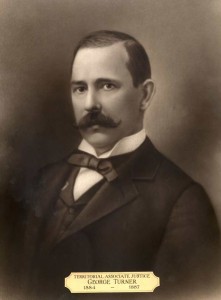Countdown to the November 8th Day of Jubilation – Part 10
 1887 and 1888 proved to be dark years for the women’s suffrage movement in Washington. In the 1887 case of Harland v. Territory, the Territorial Supreme Court overturned the Women’s Suffrage Act of 1886 because it allowed women to serve on juries. Justice George Turner (photo on left courtesy of Washington State Archives), who firmly believed that women were incapable of voting intelligently on public matters (tsk-tsk!), ruled that the title of the 1886 election law was defective and the law giving women the right to vote was revoked. The ruling of the court snatched the voting franchise away from women before they had a real chance to exercise it.
1887 and 1888 proved to be dark years for the women’s suffrage movement in Washington. In the 1887 case of Harland v. Territory, the Territorial Supreme Court overturned the Women’s Suffrage Act of 1886 because it allowed women to serve on juries. Justice George Turner (photo on left courtesy of Washington State Archives), who firmly believed that women were incapable of voting intelligently on public matters (tsk-tsk!), ruled that the title of the 1886 election law was defective and the law giving women the right to vote was revoked. The ruling of the court snatched the voting franchise away from women before they had a real chance to exercise it.
On January 18, 1888, the Washington Territorial Legislature passed a new law, specifically stating: “That all citizens of the United State, male and female, above the age of twenty-one years . . . shall be entitled to vote at any election in this Territory. . .” However, the law went on to state: “. . . nothing in this act shall be so construed as to make it lawful for women to serve as jurors.” Once the January law was passed, women could vote once again, but they couldn’t serve on juries.
Believing that women’s suffrage would conflict with his business interests, saloon owner Edward Bloomer of Spokane hatched a plot to end women’s suffrage. On April 3, 1888, Bloomer marched his wife, Nevada, to the polls. After marking her ballot, she handed it to the election official who, as pre-arranged, refused to accept it. A few days later, Nevada Bloomer sued the election officials for $5,000 for “wrongfully depriving her of the privilege of voting.” The case was appealed to the Territorial Supreme Court. On August 14, 1888, the Court struck down the territorial women’s suffrage law, asserting that “citizen” meant male citizenship, and that the territorial law conflicted with federal law.